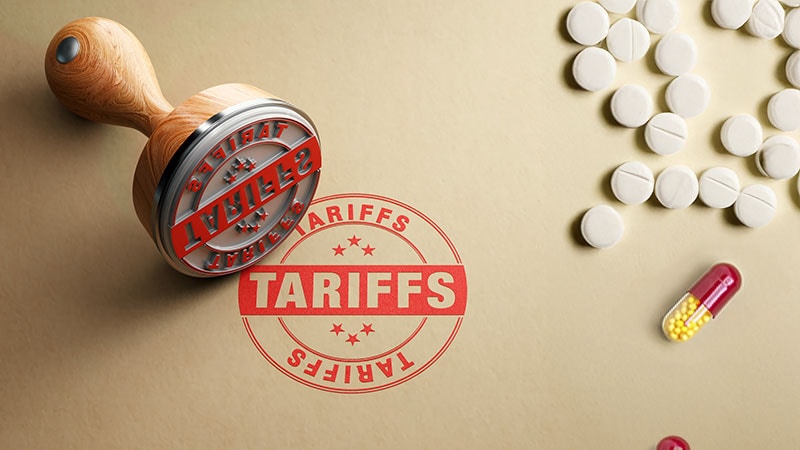Pharmaceutical tariffs, as proposed by President Donald Trump, aim to boost manufacturing jobs in the US, curb foreign profits, and bolster national security. However, such tariffs could increase the price and reduce the availability of both branded and generic medications, according to two health policy experts.
In an online press briefing on Wednesday, June 11, Mariana Socal, MD, PhD, and Jeromie Ballreich, PhD — both associate professors in the Department of Health Policy and Management at the Johns Hopkins Bloomberg School of Public Health in Baltimore — outlined potential ramifications and responded to journalists’ questions.
Pharmaceuticals Are Still Exempt — for Now
To date, pharmaceutical drugs have been exempted from tariffs. However, Trump has stated repeatedly that his administration plans to impose major tariffs on them soon.
“Branded pharmaceuticals only account for about 15% of US prescriptions,” Ballreich said. “However, they account for nearly 90% of spending.” Over the past 20 years, he noted, much of the manufacturing has shifted overseas, not to low-income countries to save labor costs, but to high-income countries — primarily Switzerland, Ireland, and Germany — for tax benefits.
“Today the US pays three to four times more than other developed countries for the same branded drugs,” Socal said. As a result, “about 1 in 4 Americans report not being able to afford the medications they need. If tariffs are applied to prescription drugs, one of the most immediate consequences could be price increases.”
The market for generics is separate, she explained. These drugs typically cost much less and account for the vast majority of prescriptions. “For generics, the biggest issue isn’t cost — it’s supply shortages. Hospitals report daily struggles to care for patients because there is a shortage of some drug they need.”
Tariffs on generic products may exacerbate shortages, she warned. Because they have lower profit margins and no patent protection, tariffs may discourage production or lead countries to cut corners, increasing the risk for supply disruptions.
If implemented, tariffs could range from 25% to 50%, Ballreich said. “We expect these tariffs to be passed on to the Medicare program, and ultimately patients will either pay more at the pharmacy or face higher Medicare Part D premiums.”
Signs of Anticipation
In anticipation of potential tariffs, Ballreich said there’s already been a surge in pharmaceutical imports. “To put it in perspective, Ireland — our single largest source of branded pharmaceuticals — saw a fivefold increase in US imports in the month of March year over year.”
While the US does maintain some drug stockpiles, Socal noted these are primarily for bioterrorism or acute emergency response. Proposals have been floated for hospitals to stockpile certain drugs, especially injectable medications frequently in shortage, but the scope remains unclear. “We cannot have stockpiles over stockpiles for every single drug,” she said. “Policies to resolve supply disruptions and shortages should be the way to go.”
Unintended Consequences
Socal also pointed to the Inflation Reduction Act of 2022, which created the Medicare drug price negotiation program and introduced an inflation rebate penalty for manufacturers who raise prices faster than inflation. That penalty applies to Medicaid prescriptions as well. Penalizing offending manufacturers, she said, “can have an unintended consequence. If the manufacturer cannot raise prices because the penalty might be too high, one of the possibilities is that the manufacturer may simply want to discontinue a drug.”
US Manufacturing Still Years Away
When asked how long it would take to scale up domestic production of branded drugs, Ballreich said, “Years.” While most drugs are small-molecule and typically pills, biologics are much more complex, he noted. “I don’t think we’re going to see a significant surge in domestic or US manufacturing of branded pharmaceuticals in the near term, that is, within the next year or 2.”
He said reassessing tax policy should be prioritized because “that’s why many of the manufacturers have located outside the US, particularly to other high-income countries. We also have to think about other subsidies and making sure we have a very well-developed, well-trained workforce.”
Socal emphasized that many drugs are already made in the US, but domestic manufacturers still depend heavily on foreign ingredients and raw materials. “Tariffs on pharmaceutical products coming in from abroad can also hurt our US manufacturers because their prices may then be less competitive in the global market,” she said.
Socal reported receiving research grants to the institution (Johns Hopkins Bloomberg School of Public Health) from the US Department of Defense, Arnold Ventures, the California Department of Health Care Access and Information, and the ERISA Industry Committee.
Ballreich reported receiving consulting fees from RTI International for work related to Medicare price negotiations and research grants to the institution (Johns Hopkins Bloomberg School of Public Health) from the US Department of Defense and Arnold Ventures.
Marcia Frellick is an independent, Chicago-based healthcare journalist and a regular contributor to Medscape Medical News.
Source link : https://www.medscape.com/viewarticle/how-proposed-tariffs-could-disrupt-us-drug-prices-and-supply-2025a1000ga0?src=rss
Author :
Publish date : 2025-06-18 13:21:00
Copyright for syndicated content belongs to the linked Source.
